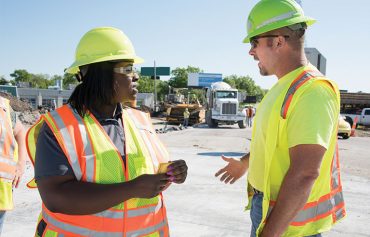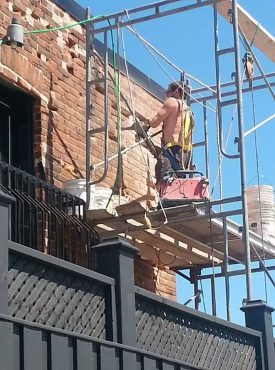
John Bleasby
Had a safety conversation with your workers lately?
Canadian ContractorTalking about safety in an open, positive manner is critical for all contractors
“The most recent statistics from the Association of Workers’ Compensation Boards of Canada (AWCBC) say that in 2017, 951 workplace fatalities were recorded in Canada, an increase of 46 from the previous year,” according to the Canadian Centre for Occupational Health and Safety. “Among these deaths were 23 young workers aged 15-24.” It’s therefore vital that every contractor establish safety and health as core values, particularly with those younger team members. It should start with safety conversations.

A one-on-one safety conversation might seem like a confrontation. Better to set up a group meeting where ideas can be openly exchanged
Getting the conversation started
One can have good, constructive conversations about safety, or useless ones. “Hey! Don’t let me see you doing that again!” is not a good safety conversation. It’s likely the worker will react poorly to the criticism and revert to that behaviour again in the future. A good and effective conversation is more than simply telling workers to be safe — they need to know that you want to proactively address issues and hazards that could injure them or make them sick.
To help you get started, here are a culmination of ideas from several different sources in both Canada and the U.S., such as SafeStart, a safety training programme operator based in Belleville, Ontario, EHS Today, the U.S. Occupational Health and Safety Authority, and Safety and Health magazine.
Why have safety conversations at all?
“Traditionally, we’re taught to be polite, which often has meant, ‘Keep your opinions to yourself and don’t make waves,’” Susan Koen, Practice Leader and Executive Consultant, DEKRA Insight, told Safety and Health magazine. “We’re not taught in our culture how to be collaborative, how to give and receive constructive feedback, so it’s difficult for people to give feedback, period.”
In the same article, research psychologist Steve Casner, says, “For whatever reason, people just can’t stand being given advice.” Casner also believes that workers may simply not perceive themselves to be in danger, or that they’ve heard it all before and block out the advice.
Koen adds the worker can easily interpret the advice as a form of aggression being displayed by the person handing it out. “There’s an underlying sense that if somebody’s about to do something wrong, they’re either ignorant, inept or indifferent,” she said. “And if you haven’t really thought through those beliefs, they will come through in ways that the receiver hears. The discomfort is compounded when someone is unsure about how a message will be received. It’s very important to understand that most people about to commit an unsafe act are not doing it intentionally.”

Working at heights is one area of safety that always need to be addressed
(photo: John Bleasby)
Your conversation planning checklist
Conversations need to be planned as part of an ongoing safety management process within your company. Be clear about the motives behind the meeting or conversation from the outset. It’s not about control, or a ‘gotcha’ opportunity — It’s about caring.
Anticipate the risks
Don’t wait for an incident to occur. Try the walking around the site and asking workers where they think potential safety issues might arise. Ask questions like, “What is your biggest safety concern with this task?” or “What can we do to make this task safer?”
Think about your questions
Using questions is a great technique, but do they encourage engagement rather than a one-word response? “It’s a good idea to use words like: why, what, how, etc. and listen to the answers.” Recognize that you don’t know it all. “Making up an answer, giving an incomplete one or changing the subject won’t fool anyone.”
Be positive
“Research indicates that negative feedback is two to four times more powerful than positive feedback, but in a negative way. If you want to promote a positive environment, limit negative feedback and give twice as much positive feedback. Praise with enthusiasm, criticize lightly. When giving appreciation, thank the person for doing something positive for safety.” Say things like, “I really appreciate the way you brought up the safety issue without getting people upset.” Or “Thanks for pointing out that safety issue. Your actions could keep somebody from getting hurt.” Allowing workers to be honest and open without fear of reprimand will build trust and intimacy.
Listen, don’t preach!
“Safety lectures are predictable; safety conversations can be new and interesting. So being brief and avoiding repetition is the way forward.” Look for collaborative solutions. Use an active listening technique that includes mirroring or repeating what the person is telling you, paraphrasing the message, summarizing content, asking for clarification, and acknowledging feelings.
Focus on the conversation, not on mobile devices.
“Participants need to be involved and fully engaged in the safety conversation. The workers deserve their undivided attention.” So put that phone down.

A safe team is a happy team
(photo: John Bleasby)
Watch out for segues
“Sometimes a safety chat about one subject can turn into a discussion about something completely different.” That’s OK if it becomes an important topic, so long as you return to the original one or set a time for it to be discussed.
Summarize effectively
“Ask the workers to summarize the conversation. Ask for feedback about the conversation itself to see how well it was handled. Did the workers feel listened to? Did they feel that their time and position on the topic were respected? Their feedback can allow for improvements to future conversations.”
Develop action plans
“Ask workers for ideas on improvements and follow up on their suggestions….End by asking about the worker’s understanding and strategies for improvement. Discuss what the worker could do differently. Give your own suggestions and commit to monitoring improvement together.” If one does not exist, implement a reporting process and initiate safety training as required.
And finally…
Lead by example. Practice safe behaviors yourself and make safety part of your daily conversations with workers. Safety conversations should not be one-off events — they need to be regular in order to address the changing job site or to engage new and younger members of the construction team.
Got feedback? Make your opinion count by using the comment section below
Advertisement
Print this page

They have to be safely hat and vest , harnesses too and safety boots too and also not talk on cellphone while you work that be safely just watch walk way thing on ground or clean up thing